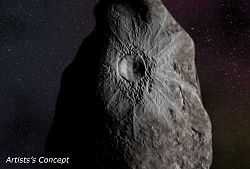8405 Asbolus
|
Artist's impression of 8405 Asbolus | |
| Discovery | |
|---|---|
| Discovered by | J. V. Scotti and R. Jedicke |
| Discovery date | April 5, 1995 |
| Designations | |
Named after | Asbolus |
| 1995 GO | |
| centaur | |
| Orbital characteristics[1] | |
| Epoch November 30, 2008 (JD 2454800.5) | |
| Aphelion | 29.31 AU |
| Perihelion | 6.843 AU |
| 18.07 AU | |
| Eccentricity | 0.6214 |
| 76.88 yr | |
| 29.6 | |
| Inclination | 17.61 |
| 6.0 | |
| 290.4 | |
| Physical characteristics | |
| Dimensions |
84 ± 8 km (Spitzer)[2] 76 km (Johnston)[3] |
| 8.87 hr[1] | |
| Albedo |
0.05[2] |
| ~21.1[5] | |
| 9.0[1] | |
|
| |
8405 Asbolus (/ˈæzbɵləs/; from Greek: Άσβολος) is a centaur orbiting between the orbits of Jupiter and Neptune. It was discovered by James V. Scotti and Robert Jedicke of Spacewatch at Kitt Peak Observatory on April 5, 1995. It is named after Asbolus (Greek for sooty), a centaur in Greek mythology. Its provisional designation was 1995 GO.
Features
Observations with the Spitzer Space Telescope in 2007 resulted in a diameter calculation of about 84 ± 8 km.[2]
Fresh crater
No resolved images of it have ever been made, but in 1998 spectral analysis of its composition by the Hubble Space Telescope revealed a fresh impact crater on its surface, less than 10 million years old.[6] Centaurs are dark in colour, because their icy surfaces have darkened after long exposure to solar radiation and the solar wind. However, fresh craters excavate more reflective ice from below the surface, and that is what Hubble has detected on Asbolus.
Orbit
Centaurs have short dynamical lifetimes due to perturbations by the giant planets. Asbolus is estimated to have an orbital half-life of about 860 kiloannum.[7] Asbolus is currently classified as a SN centaur since Saturn is considered to control the perihelion and Neptune controls the aphelion.[7] Asbolus currently has a perihelion (q) of 6.8AU,[1] so is also influenced by Jupiter. Centaurs with a perihelion less than 6.6AU are very strongly influenced by Jupiter and for classification purposes are considered to have a perihelion under the control of Jupiter.[7] In about ten thousand years, clones of the orbit of Asbolus suggest that its perihelion classification may come under the control of Jupiter.[8]
Predicting the overall orbit and position of Asbolus beyond a few thousand years is difficult because of errors in the known trajectory, error amplification by perturbations due to all of the gas giants, and the possibility of perturbation as a result of cometary outgassing/fragmentation. Compared to centaur Nessus, the orbit of Asbolus is currently much more chaotic.

References
- ↑ 1.0 1.1 1.2 1.3 "JPL Small-Body Database Browser: 8405 Asbolus (1995 GO)" (February 26, 2008 last obs). Retrieved September 3, 2008.
- ↑ 2.0 2.1 2.2 John Stansberry, Will Grundy, Mike Brown, Dale Cruikshank, John Spencer, David Trilling, Jean-Luc Margot (2007). "Physical Properties of Kuiper Belt and Centaur Objects: Constraints from Spitzer Space Telescope". arXiv:astro-ph/0702538 [astro-ph]. Bibcode:2008ssbn.book..161S. Unsupported parameter(s) in cite arXiv (help)
- ↑ Wm. Robert Johnston (August 22, 2008). "List of Known Trans-Neptunian Objects". Johnston's Archive. Archived from the original on 16 December 2006. Retrieved December 17, 2006.
- ↑ Fernández, Yanga R.; Jewitt, David C.; Sheppard, Scott S. (February 2002). "Thermal Properties of Centaurs Asbolus and Chiron". The Astronomical Journal 123 (2): 1050–1055. arXiv:astro-ph/0111395. Bibcode:2002AJ....123.1050F. doi:10.1086/338436.
- ↑ "AstDys (8405) Asbolus Ephemerides". Department of Mathematics, University of Pisa, Italy. Retrieved June 28, 2010.
- ↑ "Centaur's Bright Surface Spot Could be Crater of Fresh Ice". Hubblesite (STScI-2000-31). September 14, 2000. Retrieved April 12, 2004.
- ↑ 7.0 7.1 7.2 Horner, J.; Evans, N.W.; Bailey, M. E. (November 2004). "Simulations of the Population of Centaurs I: The Bulk Statistics". Monthly Notices of the Royal Astronomical Society 354 (3): 798–810. arXiv:astro-ph/0407400. Bibcode:2004MNRAS.354..798H. doi:10.1111/j.1365-2966.2004.08240.x.
- ↑ "The perihelion (q) of twenty-two clones of Centaur Asbolus". Retrieved April 26, 2009. (Solex 10)
- ↑ "Three clones of Centaur 8405 Asbolus making passes within 450Gm". Retrieved May 2, 2009. (Solex 10)
External links
- Orbital simulation from JPL (Java) / Ephemeris
| ||||||
| ||||||||||||||||||||||||||||
